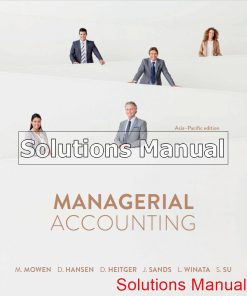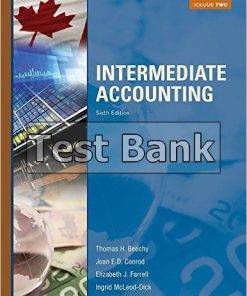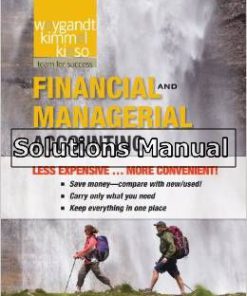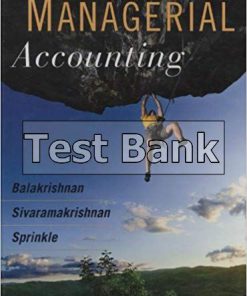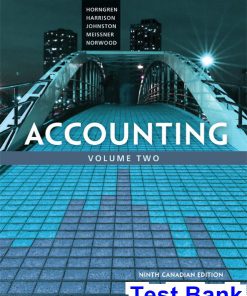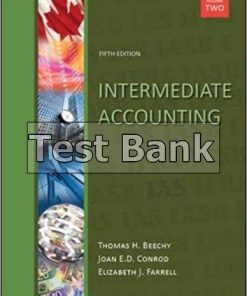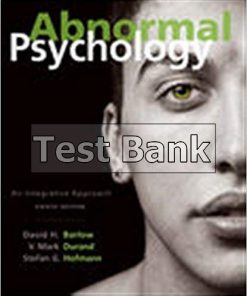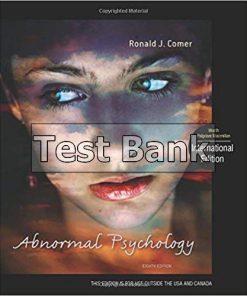MANAGERIAL ACCOUNTING Version 2 1st Edition Heisinger Test Bank
$26.50$50.00 (-47%)
MANAGERIAL ACCOUNTING Version 2 1st Edition Heisinger Test Bank.
You may also like
MANAGERIAL ACCOUNTING Version 2 1st Edition Heisinger Test Bank
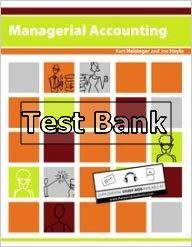
Product details:
- ISBN-10 : 1453345272
- ISBN-13 : 978-1453345276
- Author:
Table contents:
1 Managerial Accounting in the Information Age 1-1
Goal of Managerial Accounting 1–2
Cost Terms Used in Discussing Planning, Control, and Decision Making 1–7
Two Key Ideas in Managerial Accounting 1–10
The Information Age and Managerial Accounting 1–13
Ethical Considerations in Managerial Decision Making 1–17
The Controller as the Top Management Accountant 1–20
Chapter Review: Summary of Learning Objectives / Review Problems / Key Terms / Self-Assessment 1–22
End-of-Chapter Homework: Questions / Exercises / Problems / Cases 1–25
Appendix: IMA Statement of Ethical Professional Practice 1–32
2 Job-Order Costing for Manufacturing and Service Companies 2-1
Cost Classifications for Manufacturing Firms 2–2
Product Cost Information in Financial Reporting and Decision Making 2–6
Balance Sheet Presentation of Product Costs 2–7
Flow of Product Costs in Accounts 2–8
Income Statement Presentation of Product Costs 2–8
Types of Costing Systems 2–11
Overview of Job Costs and Financial Statement Accounts 2–11
Job-Order Costing System 2–13
Eastlake Revisited: Using Job Cost Information 2–18
Relation Between the Costs of Jobs and the Flow of Costs in Work in Process, Finished Goods, and Cost of Goods Sold 2–19
Allocating Overhead to Jobs: A Closer Look 2–20
Predetermined Overhead Rates 2–21
Job-Order Costing for Service Companies 2–24
Modern Manufacturing Practices and Product Costing Systems 2–27
Chapter Review: Summary of Learning Objectives / Review Problems / Key Terms / Self-Assessment 2–30
End-of-Chapter Homework: Questions / Exercises / Problems / Cases 2–35
3 Process Costing 3-1
Difference between Job-Order and Process Costing Systems 3–2
Product and Cost Flows 3–3
Calculating Unit Cost 3–6
Calculating and Applying Cost per Equivalent Unit: Mixing Department Example 3–7
Production Cost Report 3–9
Basic Steps in Process Costing: A Summary 3–11
Kent Chemical Revisited: Answering Stacy’s Question 3–12
Dealing with Transferred-in Cost: Packaging Department Example 3–12
Process Costing and Incremental Analysis 3–14
“You Get What You Measure!” and Manufacturing Processes 3–15
Chapter Review: Summary of Learning Objectives / Review Problems / Key Terms / Self-Assessment 3–16
End-of-Chapter Homework: Questions / Exercises / Problems / Cases 3–20
4 Cost-Volume-Profit Analysis 4-1
Common Cost Behavior Patterns 4–2
Cost Estimation Methods 4–6
Cost-Volume-Profit Analysis 4–14
Multiproduct Analysis 4–19
Assumptions in CVP Analysis 4–23
Codeconnect Example Revisited: Answering Mary’s Questions 4–23
Operating Leverage 4–24
Constraints 4–25
Chapter Review: Summary of Learning Objectives / Review Problems / Key Terms / Self-Assessment 4–26
End-of-chapter Homework: Questions / Exercises / Problems / Cases 4–30
Appendix: Using Regression in Microsoft Excel to Estimate Fixed and Variable Costs 4–46
5 Variable Costing 5-1
Full (Absorption) and Variable Costing 5–2
Effects of Production on Income for Full Versus Variable Costing: The Clausentube Example 5–5
Benefits of Variable Costing for Internal Reporting 5–12
Variable Costing Limits Management of Earnings via Production Volume 5–12
Chapter Review: Summary of Learning Objectives / Review Problems / Key Terms / Self-Assessment 5–13
End-of-Chapter Homework: Questions / Exercises / Problems / Cases 5–17
6 Cost Allocation and Activity-Based Costing 6-1
Purposes of Cost Allocation 6–2
Process of Cost Allocation 6–5
Allocating Service Department Costs 6–8
Problems with Cost Allocation 6–10
Activity-Based Costing 6–14
Activity-Based Management 6–23
Remember—You Get What You Measure! 6–24
Chapter Review: Summary of Learning Objectives / Review Problems / Key Terms / Self-Assessment 6–25
End-of-Chapter Homework: Questions / Exercises / Problems / Cases 6–29
Appendix: Activity-Based Management 6–46
7 The Use of Cost Information in Management Decision Making 7-1
Incremental Analysis 7–2
Analysis of Decisions Faced by Managers 7–5
Decisions Involving Joint Costs 7–14
Qualitative Considerations in Decision Analysis 7–17
Chapter Review: Summary of Learning Objectives / Review Problems / Key Terms / Self-Assessment 7–18
End-of-Chapter Homework: Questions / Exercises / Problems / Cases 7–21
Appendix: The Theory of Constraints 7–34
8 Pricing Decisions, Customer Profitability Analysis, and Activity-Based Pricing 8-1
The Profit-Maximizing Price 8–2
Pricing Special Orders 8–4
Cost-Plus Pricing 8–5
Target Costing 8–7
Analyzing Customer Profitability: Revisiting the Priced Right Office Supplies Case 8–8
Customer Profitability and Performance Measures 8–11
Activity-Based Pricing 8–11
Chapter Review: Summary of Learning Objectives / Review Problems / Key Terms / Self-Assessment 8–12
End-of-Chapter Homework: Questions / Exercises / Problems / Cases 8–19
9 Capital Budgeting and Other Long-Run Decisions 9-1
Capital Budgeting Decisions 9–2
Evaluating Investment Opportunities: Time Value of Money Approaches 9–3
Considering “Soft” Benefits in Investment Decisions 9–11
Estimating the Required Rate of Return 9–13
Additional Cash Flow Considerations 9–14
Other Long-Run Decisions 9–17
Simplified Approaches to Capital Budgeting 9–18
Conflict between Performance Evaluation and Capital Budgeting 9–21
Wilson Air Example Revisited 9–23
Chapter Review: Summary of Learning Objectives / Review Problems / Key Terms / Self-Assessment 9–24
End-of-Chapter Homework: Questions / Exercises / Problems / Cases 9–27
Appendix A: Using Microsoft Excel to Calculate NPV and IRR 9–36
Appendix B 9–39
10 Budgetary Planning and Control 10-1
Use of Budgets in Planning and Control 10–2
Developing the Budget 10–4
The Master Budget 10–5
Use of Computers in the Budget Planning Process 10–14
Budgetary Control 10–14
Investigating Budget Variances 10–17
Conflict in Planning and Control Uses of Budgets 10–18
Evaluation, Measurement, and Management Behavior 10–19
The Preston Joystick Case Revisited 10–20
Chapter Review: Summary of Learning Objectives / Review Problems / Key Terms / Self-Assessment 10–20
End-of-Chapter Homework: Questions / Exercises / Problems / Cases 10–26
11 Standard Costs and Variance Analysis 11-1
Standard Costs 11–2
A General Approach to Variance Analysis 11–5
Material Variances 11–5
Direct Labor Variances 11–7
Overhead Variances 11–8
Test Your Knowledge: Comprehensive Example 11–13
Investigation of Standard Cost Variances 11–16
Responsibility Accounting and Variances 11–19
Chapter Review: Summary of Learning Objectives / Review Problems / Key Terms / Self-Assessment 11–19
End-of-Chapter Homework: Questions / Exercises / Problems / Cases 11–23
Appendix: Recording Standard Costs in Accounts 11–33
12 Decentralization and Performance Evaluation 12-1
Why Firms Decentralize 12–2
Why Companies Evaluate the Performance of Subunits and Subunit Managers 12–4
Cost Centers, Profit Centers, and Investment Centers 12–6
Evaluating Investment Centers with ROI 12–8
Evaluation Using Economic Value Added (EVA) 12–13
Using a Balanced Scorecard to Evaluate Performance 12–18
Developing a Strategy Map for a Balanced Scorecard 12–21
Keys to a Successful Balanced Scorecard: Targets, Initiatives, Responsibility, Funding, Top Management Support 12–22
Chapter Review: Summary of Learning Objectives / Review Problems / Key Terms / Self-Assessment 12–23
End-of-chapter Homework: Questions / Exercises / Problems / Cases 12–28
Appendix: Transfer Pricing 12–39
Glossary G-1
Index I-1
Chapters 13 & 14 Available in WileyPLUS
13 Statement of Cash Flows 13-1
Need for a Statement of Cash Flows 13-2
Types of Business Activities and the Classification of Cash Flows 13-2
The Statement of Cash Flows Prepared Using the Direct Method 13-5
Preparing the Statement of Cash Flows Using the Indirect Method 13-9
Interpreting Information in the Statement of Cash Flows: The Situation at Ravira Restaurant Supply 13-13
Chapter Review: Summary of Learning Objectives / Review Problems / Key Terms / Self-Assessment 13-14
End-of-Chapter Homework: Questions / Exercises / Problems / Case 13-18
14 Analyzing Financial Statements: A Managerial Perspective 14-1
Why Managers Analyze Financial Statements 14-2
Horizontal and Vertical Analyses 14-4
Earnings Management and the Need to Compare Earnings and Cash-Flow Information 14-7
Other Sources of Information on Financial Performance 14-9
Ratio Analysis 14-10
A Managerial Perspective on the Analysis of HGW’S Financial Statements 14-14
Summary of Analyses 14-16
Chapter Review: Summary of Learning Objectives / Review Problems / Key Terms / Self-Assessment 14-17
End-of-chapter Homework: Questions / Exercises / Problems / Cases 14-21
People also search:
MANAGERIAL ACCOUNTING Version 2 1st
MANAGERIAL ACCOUNTING Version 2 1st pdf
MANAGERIAL ACCOUNTING Version 2 1st edition
MANAGERIAL ACCOUNTING Version 2 1st pdf free
MANAGERIAL ACCOUNTING Version 2 1st download scribd

